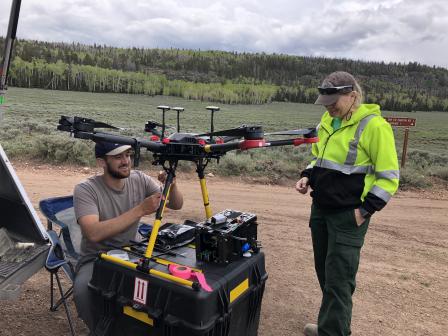Studies Advance Air Monitoring During Wildfires and Improve Forecasting of Smoke
Published July 30, 2019 The Kolibri air sensor, a lightweight sampler developed by EPA researchers, samples chemical, particle, and biological pollutants as it is carried through smoke in an unmanned aircraft system.
The Kolibri air sensor, a lightweight sampler developed by EPA researchers, samples chemical, particle, and biological pollutants as it is carried through smoke in an unmanned aircraft system.
This summer, EPA is testing air monitoring equipment during wildfires and studying wildfire emissions. The work is part of a scientific effort to evaluate regulatory and low-cost air sampling equipment during smoke conditions, better understand the chemistry of smoke, and improve models used to forecast where smoke from wildland fires will travel.
The Mobile Ambient Smoke Investigation Capability (MASIC) study that began in May will collect air measurements from both regulatory-grade and low-cost air sensors and determine their performance capabilities during large and intense wildfires.
Researchers will drive two mobile laboratories filled with monitoring equipment to wildfires when they occur in the Northwest. One mobile laboratory holds state- of- the-art research grade instruments and regulatory air quality monitors. The second mobile laboratory contains low-cost air quality sensors and other small form factor measuring instruments.
In addition, three stationary labs in wildfire-prone areas have been set up with additional regulatory and research grade instrumentation and low-cost sensors and other small air sampling devices. The labs are located near Reno, Nevada, Boise, Idaho, and at a U.S. Forest Service research facility in Missoula, Montana. Researchers will collect air data, compare the performance of low-cost sensors and other small samplers at the labs to nearby regulatory monitors during wildfire smoke impact events.
“This study will help us to interpret data from regulatory monitoring and sensor networks during wildfires and also provide information on the efficacy of using rapidly deployable devices for fire incident response,” explains EPA researcher Matt Landis. The research will continue for two additional fire seasons in 2020 and 2021.
The MASIC study is also contributing to FIREX-AQ, a large interagency field study taking place in the Northwest and Southeast this summer and led by NASA and National Oceanic and Atmospheric Administration (NOAA). Using satellites, aircraft, and ground monitoring, the study will help to answer how fuel and fire conditions may affect smoke components and chemistry, what conditions result in plume and transport of smoke over distances, and what impacts smoke has on air quality as it undergoes chemical transformation and aging. The results will be applied to remote sensing monitoring by satellites and models to improve predictions for smoke from wildfires and prescribed burns.
Studying Emissions and Fire Behavior
In Fishlake National Forest in Utah, EPA participated in a week-long air sampling activity during a controlled forest burn by the U.S. Forest Service. Over 40 scientists from the Desert Research Institute (DRI), University of Idaho, and other agencies and universities participated in the comprehensive study called the Fire and Smoke Model Evaluation Experiment (FASMEE).
The Kolibri air sensor, a lightweight sampler developed by EPA researchers, sampled chemical, particle, and biological pollutants as it was carried through the smoke in an unmanned aircraft system owned by DRI.
The prescribed burn provided wildfire-like conditions, with heavy surface fuel loads and high burn intensity, giving researchers a unique opportunity to study fire behavior, fuel consumption, smoke dispersion, and emissions. The prescribed burn will reestablish aspen stands, allowing for regrowth in what has become a mixed conifer forest.
“The Fishlake study offered us a unique opportunity to characterize near-source emissions under wildfire-like conditions,” says Brian Gullett, EPA lead investigator. “The ultimate goal is to link emissions with the fuel properties, ignition methods, and meteorological conditions to enable better prediction of smoke production during wildland fires.”
The Kolibri is a lightweight air sensor/sampler, weighing up to eight pounds, that can be used to measure a broad array of chemical, particle, and biological pollutants. Data can be recorded and transferred in real time, with measurements of a broad variety of pollutants, including particulate matter and volatile organic compounds.
Combined, the MASIC, FIREEX-AQ, and FASMEE studies are tackling smoke issues from wildfires in a variety of ways. The work will improve the ability to predict smoke from both wildfires and prescribed burns and determine what air monitors are best for measuring smoke from wildfires.
